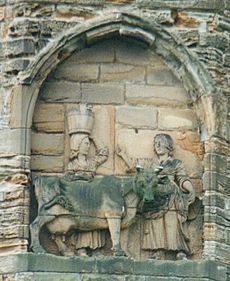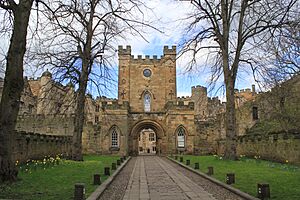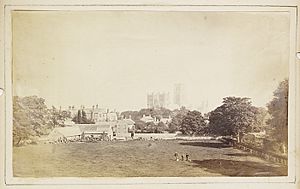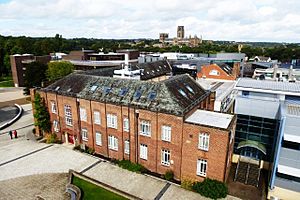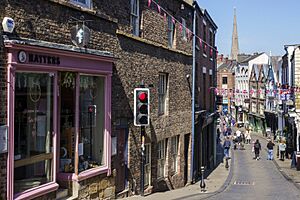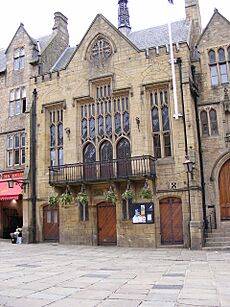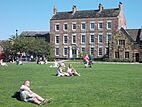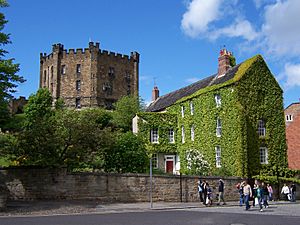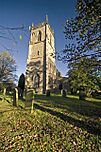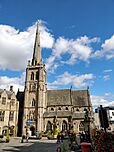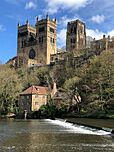Durham, England facts for kids
Quick facts for kids Durham |
|
|---|---|
| City and civil parish | |
|
|
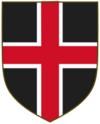 Coat of arms |
|
| Area | 14.8 km2 (5.7 sq mi) |
| Population | 50,510 (2021 census) |
| • Density | 3,413/km2 (8,840/sq mi) |
| Founded | AD 995 |
| Civil parish established | 1 April 2018 |
| Civil parish |
|
| Unitary authority |
|
| Ceremonial county | |
| Region | |
| Country | England |
| Sovereign state | United Kingdom |
| Post town | DURHAM |
| Postcode district | DH1 |
| Dialling code | 0191 |
| Police | Durham |
| Fire | County Durham and Darlington |
| Ambulance | North East |
| EU Parliament | North East England |
Durham is a historic cathedral city in the county of Durham, England. It is the main town of the county and where the local government, Durham County Council, has its offices. In 2021, about 50,510 people lived in the city area.
The city is built on a bend of the River Wear. This river wraps around the city center on three sides. The land around Durham is quite hilly, except for flatter areas near the river.
Durham was started in 995 AD by Anglo-Saxon monks. They were looking for a safe place from Viking attacks to keep the holy items of St Cuthbert. The church they built was later replaced by the amazing Durham Cathedral. This cathedral, along with Durham Castle, is now a UNESCO World Heritage Site.
For many centuries, Durham was like a mini-kingdom ruled by powerful "prince bishops." These bishops helped protect England from Scotland. A famous battle, the Battle of Neville's Cross, happened near Durham in 1346, where the English won. Later, during the Industrial Revolution, coal mining was very important here. Even though the mines are closed, the annual Durham Miners' Gala is still a huge event.
Durham is also home to Durham University, founded in 1832. It's one of the oldest universities in England. The university is a big employer, along with local government offices. Durham also attracts many visitors because of its history and beauty.
Contents
What's in a Name? The Story of Durham
The name "Durham" comes from two old words. One is "dun," which means a hill fort in an ancient British language. The other is "holme," an Old Norse word for an island. So, it means "hill island."
The Bishop of Durham even uses a Latin version of the name, "Dunelm," in his official signature. Some people believe the city's name comes from a legend about a Dun Cow. This cow supposedly guided monks carrying the body of Saint Cuthbert to this very spot in 995 AD. There's even a street called Dun Cow Lane near the cathedral!
Over time, the city's name changed. The Normans called it Duresme, and in Latin, it was Dunelm. The name "Durham" came into use later.
A Look Back: Durham's History
How Durham Began
People have lived in this area for a very long time, possibly since 2000 BC. But the city we know today really started in 995 AD. Monks from Lindisfarne chose this high, safe peninsula to build a church for the body of Saint Cuthbert.
The Legend of the Dun Cow
A local legend says that Durham was founded with a little help from above. A monk named Eadmer had a dream where Saint Cuthbert told him to take his coffin to "Dun Holm." The monks didn't know where that was.
Later, they met a milkmaid who was looking for her lost "dun cow." She said she last saw it at Dun Holm! The monks realized this was a sign and followed her. They settled on a wooded "hill-island" surrounded by the River Wear. This is where Durham Cathedral stands today. The first building was a simple wooden shelter, soon replaced by a stone church in 998 AD.
You can see this legend carved into the north side of the cathedral. There's also a modern bronze sculpture called 'Durham Cow' by the River Wear.
Durham in the Middle Ages
During the Middle Ages, Durham became very important because it was the final resting place of Saint Cuthbert and Saint Bede. Saint Cuthbert's shrine in the cathedral was a major religious site in England. People believed he could perform miracles and heal the sick. His body was also said to be "incorruptible," meaning it didn't decay.
Durham's location also made it key for defending England against the Scots. Durham Castle is famous for never being successfully attacked. In 1314, the Bishop of Durham even paid the Scots a lot of money to stop them from burning the city. The Battle of Neville's Cross in 1346 was a big English victory against the Scots near the city.
The city also suffered from outbreaks of the Bubonic plague in the 1500s.
The Powerful Bishops of Durham
Because of the city's special founding story, the Bishop of Durham had extraordinary powers. They could hold their own parliament, raise armies, and even mint their own coins! They were like rulers of their own mini-state, called the County Palatine of Durham. This was important because Durham was a "buffer state" between England and Scotland.
All these activities were managed from Durham Castle and the buildings around Palace Green. Many of these old buildings still stand today. The last bishop to rule the palatinate, Bishop William Van Mildert, helped start Durham University in 1832.
Civil War and Cromwell (1640 to 1660)
Durham supported King Charles I during the English Civil War. The city suffered when the Church of England was changed and religious places were closed. The cathedral was even used to hold 3,000 Scottish prisoners after a battle in 1650. You can still see their carvings on the stone walls inside!
After the war, in 1660, Bishop John Cosin led a big restoration project. He added beautiful woodwork to the cathedral and the famous Black Staircase in the castle.
The 18th and 19th Centuries
In the 18th century, there were ideas to make Durham a seaport, but they never happened. The city also saw the start of the trade-union movement.
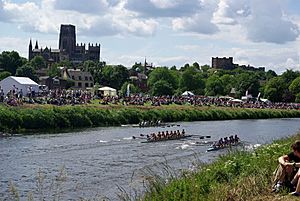
In 1835, the city's government changed to an elected body. The Bishop's special powers were mostly removed in 1836.
The first census in 1801 showed Durham had 7,100 people. The Industrial Revolution didn't change Durham as much as other cities. However, it was known for making carpets and mustard. The city was also at the heart of the coalfields, with many mines nearby. Even though the mines are gone, the traditions and community spirit remain strong.
Durham University was founded in 1832. Durham Castle became its first college, and the bishop moved to Auckland Castle. The university grew, adding more colleges over the years.
The first Durham Miners' Gala was held in 1871 with 5,000 miners. It is still the largest socialist trade union event in the world.
The 20th Century and Beyond
As coal mining declined, Durham faced tough times. However, Durham University continued to grow. New colleges and buildings were added, making it a major part of the city.
Durham was not bombed during World War II. A local legend says that a mist created by St Cuthbert protected the castle and cathedral from German planes.
In 1986, 'Durham Castle and Cathedral' was named a UNESCO World Heritage Site. This means it's recognized as a very important place for everyone in the world to protect. The cathedral is seen as one of the best examples of "Norman" architecture in England.
Durham's Geography
General Layout
The River Wear flows north through Durham, making a big loop that surrounds the city center on three sides. This creates Durham's unique peninsula. At the base of this peninsula is the Market Place, where markets are still held regularly. This area is also a main shopping spot.
Durham is a hilly city, sometimes called the "city of seven hills." The cathedral sits high up, dominating the skyline. The steep riverbanks are covered in trees, making the city very scenic. Another river, the River Browney, joins the Wear south of the city.
From the Market Place, several old roads lead out. Saddler Street goes towards Elvet Bridge and Prebends Bridge. Elvet Bridge leads to the Elvet area and the south of the city. Silver Street goes west towards Framwellgate Bridge and North Road, another main shopping area. From here, the city spreads into residential areas like Framwelgate and Crossgate.
Historical Features
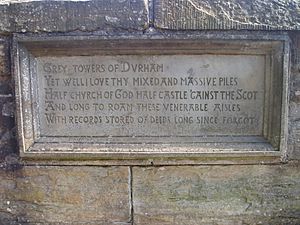
The historic center of Durham hasn't changed much in 200 years. It includes the peninsula with the cathedral, Palace Green, and Durham Castle. This was a smart defensive choice by the city's founders.
The writer Sir Walter Scott was so impressed by the view of the cathedral that he wrote a poem about it. Lines from his poem are carved into a stone tablet on Prebends Bridge.
The old commercial part of the city wraps around the peninsula. The medieval city was mostly the cathedral, castle, and administrative buildings. Areas outside, like Gilesgate and Elvet, were called townships.
Many medieval buildings in the commercial area are gone, but some Georgian buildings remain on the Bailey and Old Elvet. Many of these are now part of Durham University colleges.
Weather in Durham
Durham has a mild climate, like the rest of the United Kingdom. It gets less rain than the national average and more sunshine.
The coldest temperature ever recorded in Durham was -18.0°C in February 1895. The hottest was 36.9°C in July 2022. Durham has one of the longest weather records in England, going back to 1843.
How Durham is Governed
| City of Durham Parish Council | |
|---|---|
| Type | |
| Type |
Parish Council
|
| History | |
| Founded | 1 April 2018 |
| Leadership | |
|
Chairperson
|
Cllr Elizabeth Scott
|
|
Clerk
|
Adam Shanley
|
| Structure | |
| Seats | 15 Councillors |
|
8 / 15
|
|
|
3 / 15
|
|
|
3 / 15
|
|
|
1 / 15
|
|
| Elections | |
| Plurality-at-large | |
|
Last election
|
7 May 2019 |
|
Next election
|
2 May 2023 |
| Meeting place | |
| Millennium Pl, Durham | |
Durham used to have its own local government district. In 2009, this was changed, and Durham County Council became the main authority for the whole county, including Durham City.
Since 2009, the city's special "city status" is looked after by a group called "charter trustees." These are county councillors from the Durham area. They also choose the Mayor of Durham.
Durham's representative in the UK Parliament is Mary Foy, who is from the Labour Party.
The Durham Town Hall is in the Market Place. The oldest part of it, the guildhall, dates back to 1665.
In 2018, a new parish council was created for Durham City. This council has 15 members elected every four years. They look after things like burial grounds, community gardens, and some street lights.
Important Places in Durham
The entire center of Durham is a special "conservation area," meaning its historic character is protected. Besides the Cathedral and Castle, Durham has over 630 listed buildings, which are buildings recognized for their special historical or architectural importance.
Main Historic Buildings (Grade I listed)
These are the most important historic buildings:
- Chorister School
- Crook Hall
- Durham Castle
- Durham Cathedral
- Elvet Bridge
- Framwellgate Bridge
- Kepier Hospital
- Kingsgate Bridge
- Prebends Bridge
Other Important Buildings (Grade II* listed)
These buildings are also very important historically or architecturally:
- St. Anne's Court, Castle Chare
- Aykley Heads House (now Durham City Register Office)
- Bishop Cosin's Hall, Palace Green
- Cosin's Library (part of University Library)
- Crown Court, Old Elvet
- St Cuthbert's Society, 12 South Bailey
- St John's College, 3 South Bailey
- Railway viaduct, North Road
- Town Hall and Guildhall, Market Place
- Old Shire Hall, Old Elvet
Durham Castle
Durham Castle was built in the 11th century by the Normans. It helped them control northern England, where people were still rebelling. The Bishop of Durham lived here and used it as his headquarters.
The castle was the Bishop's home until 1832. Then, Bishop William Van Mildert gave it to Durham University to be its first college, University College, Durham. The castle has a huge Great Hall, which was once the largest in Britain. It's still 46 feet high! The castle has been used continuously for over 900 years.
Churches and Religious Buildings
Durham Cathedral was founded in its current form in 1093 AD. It's considered one of the best examples of Romanesque architecture in Europe. Its special ceiling design even helped start the Gothic style of buildings.
The cathedral is a UNESCO World Heritage Site, along with Durham Castle. It holds the shrine of Saint Cuthbert and the remains of the Venerable Bede.
Other important churches in Durham include:
- Grade I listed:
- St Giles, Gilesgate
- St Margaret of Antioch, Crossgate
- St Mary-le-Bow (now Durham Heritage Centre)
- St Oswald's, Grade II* listed
- Grade II listed:
Learning in Durham
Primary Schools
Durham has several primary schools for younger students, including:
- Shincliffe Primary School
- Finchale Primary School
- Framwellgate Moor Primary School
- Durham Blue Coat Junior School
- Durham Gilesgate Primary
- St Joseph's RCVA Primary
- St Godric's RC Primary School
- St Margaret's CofE Primary School
- St Oswald's CofE Infant School
- Nevilles Cross Primary School
- St Hild's College CE Aided Primary School
Secondary Schools
Durham has four state secondary schools:
| School | GCSE Results (percentage A* to C) | A/AS Average points |
|---|---|---|
| Belmont School Community and Arts College | 48% | N/A |
| Durham Johnston Comprehensive School | 89% | 853.1 |
| Framwellgate School Durham | 77% | 645.8 |
| St Leonard's Catholic School | 65% | 751 |
Colleges and Sixth Forms
New College Durham is the city's largest college for further education. It was formed in 1977. Its Framwellgate Moor campus has been rebuilt. The Neville's Cross site is now home to Ustinov College, a postgraduate college of Durham University.
Durham Sixth Form Centre focuses on courses for students aged 16-18. East Durham College has a campus at Houghall that specializes in land-based education.
Independent Schools
There are three independent schools in Durham:
| School | GCSE Results (percentage A* to C) | A/AS Average points |
|---|---|---|
| The Chorister School | N/A | N/A |
| Durham High School for Girls | 98% | 854.8 |
| Durham School | 76% | 807.1 |
Durham University
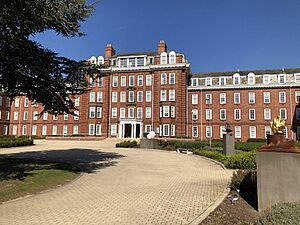
Durham is home to Durham University. It was founded in 1832 and is one of the first universities to open in England in over 600 years. It is often called England's third oldest university after Oxford and Cambridge. Durham University is known worldwide for its excellent education.
Getting Around Durham
Trains
Durham railway station is on the East Coast Main Line, which connects Edinburgh and London. Trains arrive in Durham by crossing a tall Victorian viaduct over the city.
Several train companies serve Durham, connecting it to cities like London, York, Newcastle, Liverpool, and Edinburgh. There was once another station, Durham Elvet, but it closed in 1931.
Roads
The A1(M) motorway, a modern version of the old Great North Road, runs just east of Durham. The older road, now called the A167, passes just west of the city.
Durham's market place and peninsula have a small congestion charging area, started in 2002. This means drivers pay a fee to enter certain parts of the city center.
Buses
Local bus services in Durham are run by Arriva North East and Go North East. They connect the city to nearby towns like Bishop Auckland, Darlington, and Sunderland.
Bus Station
Durham's bus station is located near North Road. It was rebuilt and reopened in January 2024. The new station has more space, toilets, and better information displays for passengers.
Park and Ride
Durham City has three Park and Ride sites (Belmont, Howlands, and Sniperley) on the edge of the city. You can park your car for free and take a bus into the city center. Buses run frequently, usually every 10 minutes.
Air Travel
The closest airports to Durham are Teesside International Airport to the south-east and Newcastle International Airport to the north. Both are about 25-30 miles away by road.
Sports in Durham
Archery
Durham has several archery clubs. Archers from these clubs compete at regional and national events.
Cricket
Durham City Cricket Club plays at Green Lane Cricket Ground. The club was formed in 1829 and is one of the oldest in the county.
Football
The city's main football club, Durham City A.F.C., used to be in the Football League. They now play in the Northern Football League.
Durham is also home to Durham Women's F.C., a professional women's football team. They are nicknamed The Wildcats and play their home games at Maiden Castle sports centre, part of Durham University.
Field Hockey
Durham has two field hockey clubs, Durham City Hockey Club and Durham University Hockey Club. They compete in various leagues across England.
Ice Hockey
Durham used to have an ice rink that was home to the Durham Wasps, a very successful British ice hockey club. The ice rink closed in 1996 and was later demolished.
Rowing
The River Wear in Durham is great for rowing, with about 1800 meters of water. Rowers pass under the arches of Elvet Bridge, which is said to be the narrowest rowing bridge in Europe.
Several rowing clubs use the river, including Durham Amateur Rowing Club, Durham University Boat Club, and many university college clubs. There are also school clubs like Durham School Boat Club.
Durham Regatta
Durham Regatta has been held on the River Wear since 1834. It is the second oldest regatta in Britain and is sometimes called 'the Henley of the North'. It takes place over two days, with many trophies to compete for.
Pleasure Boating
Besides competitive rowing, you can also rent pleasure boats on the River Wear from April to October.
Rugby
Durham City Rugby Club was founded in 1872. They have their own facility with two floodlit pitches. The club has several senior teams, a ladies' team, and mini and junior teams for younger players.
Famous People from Durham
Many notable people have connections to Durham:
- Pat Barker (born 1943), a novelist, lives in Durham.
- Tony Blair (born 1953), former Prime Minister of the United Kingdom, attended the Chorister School.
- Paul Collingwood (born 1976), an international cricketer, lives in Durham.
- James Fenton (born 1949), a journalist and poet, attended the Chorister School.
- Andy Gomarsall (born 1974), an international rugby union player, was born in Durham.
- Trevor Horn (born 1949), a famous record producer.
- Sir Peter Vardy, a businessman, attended the Chorister School.
Sister Cities
Durham has several sister cities around the world:
- Durham, North Carolina, United States
- Durham, Connecticut, United States
- Durham, New Hampshire, United States
- Tübingen, Germany
- Kreis Wesel, Germany
- Department of the Somme, France
- Banská Bystrica, Slovakia
- Nakskov, Denmark
- Alcalá de Guadaíra, Spain
- Jászberény, Hungary
After the 2022 conflict in Ukraine, Durham ended its sister city arrangement with Kostroma, Russia.
Freedom of the City
The "Freedom of the City" is a special honor given to people or military units. Those who have received it in Durham include:
Individuals
Military units
- 607 Squadron, RAF: 6 December 2017.
Images for kids
See also
 In Spanish: Durham para niños
In Spanish: Durham para niños







